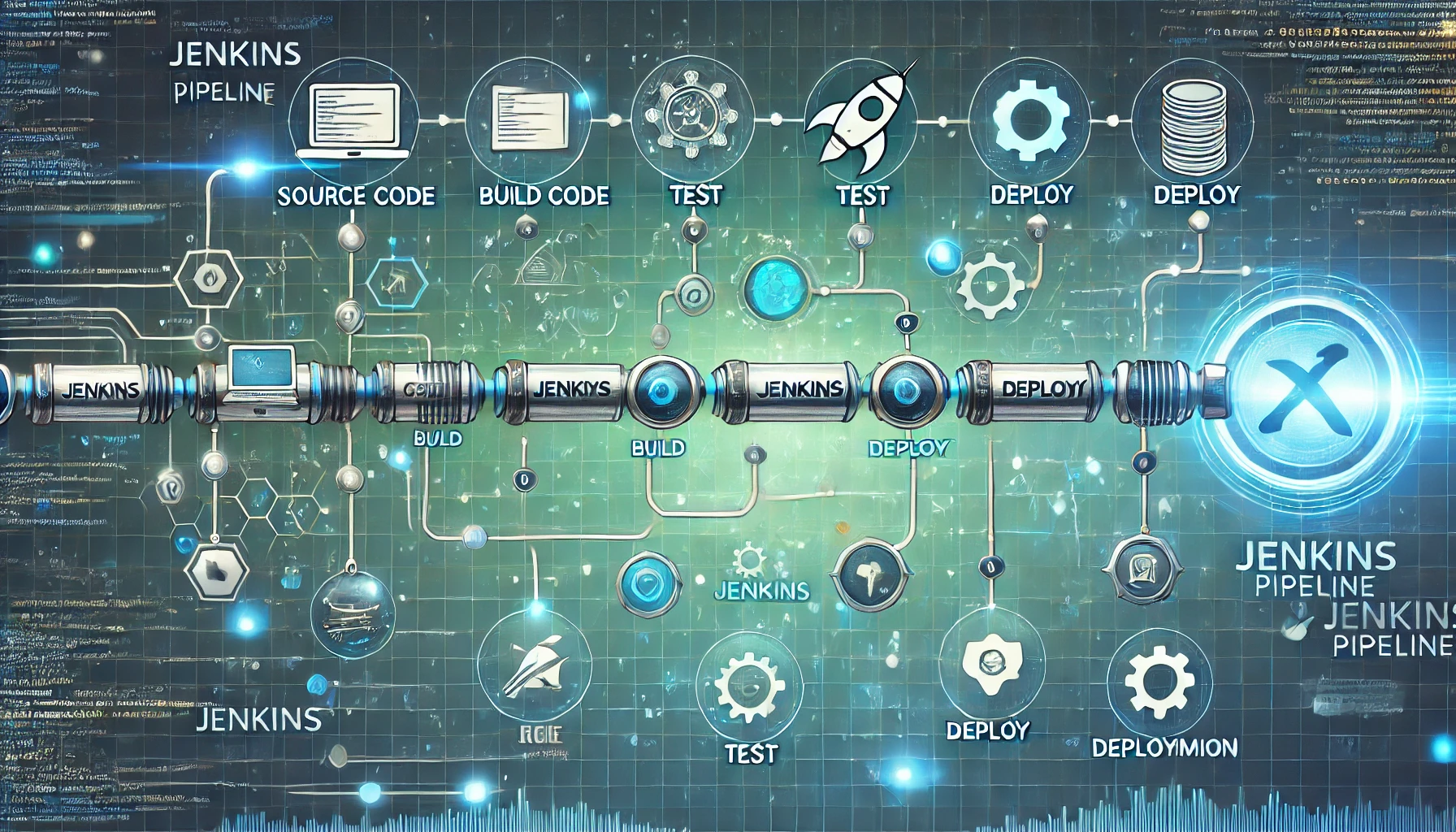Introduction to Jenkins Pipelines
Introduction to Jenkins Pipelines: Laying the Foundation for Success :-
What are Jenkins Pipelines and Why are They Important?
- Jenkins Pipelines are a suite of plugins that support implementing and integrating continuous delivery pipelines into Jenkins. They provide an elegant way to define and automate the entire software delivery process, from building and testing code to deploying it to production. Pipelines offer a significant advantage over simpler freestyle jobs by providing a more structured and robust approach to managing complex workflows. This results in improved consistency, traceability, and overall efficiency in your development lifecycle. Imagine a streamlined process where every step is automated and monitored, reducing manual errors and speeding up delivery times.
- The importance of Jenkins Pipelines lies in their ability to automate repetitive tasks, improve collaboration amongst team members, and enhance the quality and reliability of software releases. By automating the build, test, and deployment processes, organizations can reduce the risk of human error, shorten lead times for new features, and increase the frequency of releases. This ultimately leads to faster feedback loops, quicker iterations, and a more responsive development process. The ability to easily integrate with various tools and technologies within the DevOps ecosystem makes it a powerful platform for modern software development.
Key Concepts: Understanding the Building Blocks :-
- Before diving into best practices, it's crucial to understand some core concepts. Jenkins Pipelines use a declarative syntax, often written in Groovy, to define the pipeline stages. This declarative approach allows for more readable and maintainable pipelines compared to scripted pipelines. Key elements include: Stages, representing phases in the delivery process (e.g., build, test, deploy); Steps, individual tasks within each stage (e.g., running unit tests, deploying to a server); and Nodes, the environments where steps are executed (e.g., build server, test server).
- Understanding these building blocks is critical to designing efficient and effective pipelines. The declarative nature allows for easy readability and collaboration, while the modular design allows for breaking down complex processes into smaller, manageable pieces. This not only improves maintainability but also facilitates easier debugging and troubleshooting. Consider the analogy of building with Lego bricks: each brick represents a step, and by combining them strategically, you build a complex yet manageable structure.
Best Practices for Building Robust and Reliable Jenkins Pipelines :-
Pipeline as Code: The Power of Version Control :-
- Storing your pipeline definitions in version control (like Git) is paramount. This allows for tracking changes, collaboration, and easy rollback if something goes wrong. Treating pipelines as code provides all the benefits of version control, enabling a more agile and efficient approach to managing your CI/CD process. Changes to the pipeline can be reviewed, tested, and deployed with the same rigor as application code.
- Imagine a scenario where a bug is introduced into your pipeline. With pipeline-as-code, you can easily revert to a previous version, minimizing downtime and disruptions. This approach also promotes collaboration and transparency, as all changes are tracked and readily accessible to the team. Furthermore, using version control simplifies auditing and compliance requirements by maintaining a clear history of all modifications to the pipeline.
Modular Design: Breaking Down Complexity :-
- Avoid monolithic pipelines. Break down large, complex pipelines into smaller, reusable modules. This improves readability, maintainability, and testability. This approach promotes a more efficient and manageable system. Instead of one giant pipeline, consider creating smaller, focused pipelines for specific tasks or stages of the delivery process.
- Modular design allows developers to easily reuse components across different pipelines, reducing redundancy and promoting consistency. This also enables easier debugging and troubleshooting because each module can be tested and refined independently. Think of it like creating Lego sets: you can build different models using the same set of bricks, adapted to different needs. This reduces development time and promotes better code organization.
Parameterization: Enhancing Flexibility and Reusability :-
- Use parameters to make your pipelines more flexible and reusable. Parameters allow you to easily customize your pipelines for different environments or configurations. Parameters such as environment variables, build numbers or specific configurations can be passed to the pipeline to adjust its behavior. This makes the pipeline more adaptable to different scenarios without requiring significant code changes.
- Imagine a scenario where you need to deploy your application to different environments (e.g., development, staging, production). By using parameters, you can define a single pipeline that can be used for all these environments, simply by changing the parameter values. This greatly reduces the complexity and overhead associated with maintaining multiple separate pipelines. The improved reusability translates directly to time savings and reduces potential errors.
Input Validation and Error Handling: Preventing Catastrophes :-
- Implement robust input validation and error handling to prevent unexpected failures. This ensures that your pipelines can handle errors gracefully, preventing unexpected downtime or data loss. Input validation checks for the correct data type, range, format and other constraints to prevent invalid data from entering the pipeline.
- Effective error handling involves catching exceptions, logging errors, and notifying relevant stakeholders when issues arise. By implementing appropriate error handling mechanisms, you can prevent unexpected failures from cascading through the pipeline, leading to costly disruptions and delays. This involves anticipating potential issues and designing error recovery measures into the pipeline to ensure it can recover from most unexpected events.
Parallelism: Accelerating Your Builds :-
- Utilize parallelism to speed up your builds. By running multiple tasks concurrently, you can significantly reduce the overall build time. Jenkins supports the execution of several stages or steps simultaneously, leading to significant time savings, especially for large and complex projects.
- For example, you can run unit tests and integration tests in parallel to reduce the overall test execution time. This type of optimization is crucial in today's fast-paced development environments. Careful planning and implementation of parallelism techniques can substantially decrease the time required for building and testing software, ultimately resulting in faster software delivery cycles.
Environment Management: Consistency Across Stages :-
- Maintain consistent environments across all stages of your pipeline. This ensures that your application behaves as expected in each environment. Inconsistencies in environments can lead to unexpected behavior and failures. Using tools like Docker or Kubernetes can significantly improve the consistency of your environments.
- A consistent environment ensures the reliability and reproducibility of your pipeline, as any discrepancies between environments will not cause failures or unexpected behavior. This is critical for reducing the likelihood of errors during deployment, as your application will behave consistently across development, testing, and production environments. This approach also improves the reliability of your tests, as they will be run in an environment that closely resembles the production environment.
Security Considerations: Protecting Your Pipeline :-
- Implement security best practices to protect your pipeline from unauthorized access and malicious attacks. This includes using secure credentials, access control, and regular security audits. Security best practices are essential to protect sensitive data and maintain the integrity of your CI/CD pipeline.
- This may involve employing techniques like using encrypted credentials, implementing role-based access control, and regularly scanning your pipeline code for vulnerabilities. Regular security audits ensure adherence to security standards and help identify and address any potential vulnerabilities. This proactive approach helps minimize the risk of data breaches and ensures that your pipeline remains secure and reliable.
Logging and Monitoring: Tracking Progress and Identifying Issues :-
- Implement comprehensive logging and monitoring to track the progress of your pipelines and identify issues quickly. This involves logging all events, errors, and warnings during pipeline execution. Real-time monitoring provides insights into pipeline performance and helps identify potential bottlenecks or issues.
- Effective logging and monitoring are crucial for troubleshooting and debugging pipelines. Detailed logs provide a complete record of all activities, enabling you to quickly pinpoint the root cause of any failures or unexpected behavior. Real-time monitoring enables quick detection and response to problems, minimizing downtime and disruptions. This involves integrating monitoring tools that provide real-time visibility into pipeline health and performance.
Testing and Continuous Integration: Ensuring Quality :-
- Integrate thorough testing into your pipeline to ensure the quality of your code. This involves running unit tests, integration tests, and other types of tests to identify bugs early in the development process. Continuous Integration (CI) helps ensure that code changes are integrated frequently and tested automatically.
- By incorporating comprehensive testing into your pipeline, you can identify and address bugs early in the development process, significantly reducing the cost and effort associated with fixing them later on. Continuous integration ensures that code changes are integrated frequently and tested automatically, preventing conflicts and ensuring the smooth operation of the development process. This collaborative approach promotes higher quality code and reduces the risk of integration issues.
Rollback Strategies: Handling Failures Gracefully :-
- Implement rollback strategies to handle failures gracefully. This involves creating mechanisms to revert to a previous stable version of your application if a deployment fails. Rollback mechanisms help mitigate the impact of errors by quickly reverting to a known good state.
- Rollback strategies can be automated as part of your pipeline, providing a mechanism to automatically restore a previous working version in the event of a failure. This minimizes the impact of deployment errors, reduces downtime, and helps maintain the stability of your application. This ensures faster recovery from errors and prevents widespread disruption to your services.
Advanced Techniques for Optimizing Your Jenkins Pipelines :-
Pipeline Libraries: Promoting Reusability and Standardization :-
- Pipeline libraries promote code reusability and standardization. They enable creating reusable pipeline components that can be shared across multiple projects. This promotes consistency and reduces development effort. This is particularly useful for large organizations with multiple projects.
- This means less duplication of code and a reduction in the likelihood of inconsistencies across pipelines. Furthermore, maintaining a central repository of pipeline components simplifies updates and bug fixes. The standardized approach ensures consistency in the design and implementation of your pipelines, improving their maintainability and reliability. It promotes best practices throughout the organization.
Blue Ocean: A Modern Interface for Pipeline Management :-
- Blue Ocean provides a modern and intuitive interface for managing Jenkins pipelines. It offers a visual representation of your pipeline, making it easier to understand and manage complex workflows. Its user-friendly interface streamlines the process of creating, monitoring, and troubleshooting pipelines.
- Blue Ocean's visual pipeline editor allows for easy creation and modification of pipelines, reducing the need for extensive scripting knowledge. The visual representation provides a clear overview of the pipeline's progress, making it easier to identify bottlenecks and troubleshoot problems. This improves collaboration and facilitates easier understanding of the CI/CD process among team members.
Pipeline Templates: Building Flexible and Customizable Pipelines :-
- Pipeline templates provide a mechanism for creating reusable and customizable pipeline structures. They enable creating generic pipeline structures that can be adapted to different projects or environments. This flexibility improves efficiency and reduces redundancy.
- By using templates, you can establish consistent patterns across your pipelines, which helps in maintaining a standardized approach to CI/CD processes. The use of templates makes it easier to manage and update pipelines consistently across the organization. This results in better organization, easier maintenance, and improved consistency in your CI/CD workflow.
Managing Pipeline State: Tracking Progress and Status :-
- Effective pipeline state management allows you to track the progress and status of your pipelines. This involves utilizing Jenkins' built-in features or integrating with external tools to monitor the pipeline's execution, and providing visibility into its current status. This is essential for monitoring overall performance and identifying potential bottlenecks.
- Real-time visibility into pipeline status enables quick identification of issues and facilitates proactive intervention when needed. Having a clear understanding of pipeline status enables rapid troubleshooting and improves overall efficiency. This proactive approach reduces downtime and ensures smoother operations.
Integrating with Other Tools: Expanding Your Ecosystem :-
- Jenkins integrates seamlessly with many other tools in the DevOps ecosystem. This allows you to extend its functionality and create a comprehensive CI/CD pipeline. Integration with tools like SonarQube, Jira, and Slack can further enhance your workflow.
- This integration allows for streamlined workflows and automated reporting. The automated feedback loops improve collaboration and speed up the development cycle. Seamless integration with other tools provides a more cohesive and efficient development environment, reducing the effort required for manual synchronization of information across various platforms.
Conclusion: Embracing Best Practices for Continuous Delivery :-
- By adopting these best practices for Jenkins Pipelines, you can create a robust, reliable, and efficient CI/CD system. Remember, continuous improvement is key. Regularly review and refine your pipelines to ensure they remain optimized for your needs. The benefits of well-crafted pipelines are significant, leading to increased productivity, improved quality, and faster time to market.
- Embrace the power of automation, and witness the positive impact on your development process. Investing time in learning and implementing these best practices will yield significant returns in the long run, making your software delivery process more efficient, reliable, and resilient. Remember that continuous monitoring and refinement are crucial for long-term success in your CI/CD journey.
Review
Kalpesh Shewale
I am grateful to have completed my Full Stack Development with AI course at Apnaguru. The faculty's support and interactive classes helped me discover my potential and shape a positive future. Their guidance led to my successful placement, and I highly recommend this institute.
Kalpesh Shewale
I am grateful to have completed the Full Stack Development with AI course at Apnaguru. The faculty's dedicated support and hands-on approach during the classes enabled me to unlock my potential and shape a promising future. Their guidance helped me secure a placement with a good package. I highly recommend this course, and for those interested, I also suggest doing the offline version at the center for an enhanced learning experience.

Raveesh Rajput
Completing the Full Stack Development with AI course at Apnaguru was a game-changer for me. I secured an internship through this course, which gave me invaluable hands-on experience. I strongly recommend this course to anyone looking to break into the tech industry. For the best experience, I suggest attending the offline sessions at the center, where the interactive learning environment really enhances the overall experience.

swapnil shinde
Apnaguru’s Full Stack Development with AI course provided me with more than just knowledge—it opened doors to an internship that gave me real-world, hands-on experience. If you're serious about a career in tech, this course is a must. I highly recommend attending the offline sessions for the most immersive and interactive learning experience!
Kalpana Waghmare
I recently completed the Full Stack Developer with AI course on ApnaGuru, and I couldn’t be more impressed! The structure of the course, with well-organized topics and self-assessment MCQs after each section, really helped reinforce my learning. The assignments were particularly valuable, allowing me to apply what I learned in a practical way. Overall, it’s an excellent program that effectively combines full-stack development and AI concepts. Highly recommended for anyone looking to enhance their skills!
Completing the Full Stack Development with AI course at Apnaguru was a pivotal moment in my career. It not only deepened my understanding of cutting-edge technologies but also directly led to an internship that provided practical, real-world experience. If you're aiming to enter the tech field, this course is an excellent stepping stone. I especially recommend attending the in-person sessions at the center, where the dynamic, hands-on learning approach truly maximizes the benefits of the program.

Mahesh Bhosle
I completed the Full Stack Development course at Apnaguru, and it was a valuable experience. The focus on live assignments and projects gave me real-world insights, helping me apply my skills in a professional setting. The interactive live sessions, mock interviews, and question banks were excellent for job preparation. Apnaguru’s company-like environment also helped me get accustomed to real work dynamics. Overall, this course equipped me with the skills and confidence needed for a career in full-stack development. I highly recommend it to anyone seeking hands-on learning and industry relevance.
I recently completed the Full Stack course at ApnaGuru, and I’m genuinely impressed! The curriculum is well-structured, covering both front-end and back-end technologies comprehensively. The instructors are knowledgeable and provide hands-on experience through practical projects. The supportive community and resources available made learning enjoyable and engaging. Overall, it’s a great choice for anyone looking to kickstart a career in web development. Highly recommend!

Adarsh Ovhal
I recently participated in the Full Stack Development With AI Course program, and it has been incredibly beneficial. The guidance I received was tailored to my individual needs, thanks to their advanced use of AI tools. The Trainers were knowledgeable and supportive, helping me explore various educational and career paths. The resources and workshops provided were practical and insightful, making my decision-making process much clearer. Overall, I highly recommend this program to any student looking for IT Field and personalized career guidance!
Shirish Panchal
I’m currently pursuing the Full Stack Developer with AI course at ApnaGuru Training Center, and I'm impressed with what I've experienced so far. The curriculum is well-structured, covering key concepts in both front-end and back-end development, along with AI fundamentals. The instructors are knowledgeable and supportive, which makes it easy to engage and ask questions. I particularly appreciate the hands-on projects that help reinforce what I’m learning. While I’m still in the process of completing the course, I feel that I'm building a strong foundation for my future in tech. I would recommend ApnaGuru to anyone looking to explore full stack development with AI!
Apnaguru Training Center stands out as a top-notch institute for IT education. They provide a wide array of courses, including Full Stack Development, Java Full Stack, Python, Automation Testing, DevOps, and MERN/MEAN Stack, all designed to meet the demands of the modern tech industry.

Mahesh Bhosle
Apnaguru Training Center is a fantastic place for IT education! They offer a variety of courses, including Full Stack Development, Java Full Stack, and Python, all taught by knowledgeable instructors who are committed to student success. The curriculum is up-to-date and includes hands-on projects that enhance learning.
dandewar srikanth
I had an excellent experience with the full-stack web development program at APNAGURU. The instructor had in-depth knowledge of both frontend and backend technologies, which made the concepts easy to grasp. From working on HTML, CSS, JavaScript, and React for the frontend to Node.js and MongoDB for the backend, the learning curve was very smooth.
